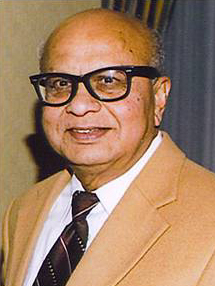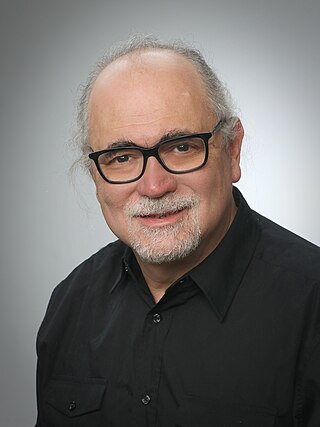
A power inverter, inverter, or invertor is a power electronic device or circuitry that changes direct current (DC) to alternating current (AC). The resulting AC frequency obtained depends on the particular device employed. Inverters do the opposite of rectifiers which were originally large electromechanical devices converting AC to DC.

Distributed generation, also distributed energy, on-site generation (OSG), or district/decentralized energy, is electrical generation and storage performed by a variety of small, grid-connected or distribution system-connected devices referred to as distributed energy resources (DER).

Power electronics is the application of electronics to the control and conversion of electric power.

A variable-frequency drive is a type of AC motor drive that controls speed and torque by varying the frequency of the input electricity. Depending on its topology, it controls the associated voltage or current variation.

Maximum power point tracking (MPPT), or sometimes just power point tracking (PPT), is a technique used with variable power sources to maximize energy extraction as conditions vary. The technique is most commonly used with photovoltaic (PV) solar systems but can also be used with wind turbines, optical power transmission and thermophotovoltaics.
Direct torque control (DTC) is one method used in variable-frequency drives to control the torque of three-phase AC electric motors. This involves calculating an estimate of the motor's magnetic flux and torque based on the measured voltage and current of the motor.
Islanding is the intentional or unintentional division of an interconnected power grid into individual disconnected regions with their own power generation.
Doubly fed electric machines, also slip-ring generators, are electric motors or electric generators, where both the field magnet windings and armature windings are separately connected to equipment outside the machine.
A line filter is an electronic filter that is placed between the mains electricity input and internal circuitry of electronic equipment to attenuate conducted radio frequencies radio frequency interference (RFI), also known as electromagnetic interference (EMI). Often it is either integrated into the power entry module or as a separate module.
A solid-state AC-to-AC converter converts an AC waveform to another AC waveform, where the output voltage and frequency can be set arbitrarily.

Bimal Kumar Bose, also known as B. K. Bose, is an electrical engineer, artificial intelligence researcher, scientist, educator, and currently a professor emeritus of power electronics in the Department of Electrical Engineering and Computer Science at the University of Tennessee, Knoxville.
A Z-source inverter is a type of power inverter, a circuit that converts direct current to alternating current. The circuit functions as a buck-boost inverter without making use of DC-DC converter bridge due to its topology.

Synchronverters or virtual synchronous generators are inverters which mimic synchronous generators (SG) to provide "synthetic inertia" for ancillary services in electric power systems. Inertia is a property of standard synchronous generators associated with the rotating physical mass of the system spinning at a frequency proportional to the electricity being generated. Inertia has implications towards grid stability as work is required to alter the kinetic energy of the spinning physical mass and therefore opposes changes in grid frequency. Inverter-based generation inherently lacks this property as the waveform is being created artificially via power electronics.

Marcelo Godoy Simões is a Brazilian-American scientist engineer, professor in Electrical Engineering in Flexible and Smart Power Systems, at the University of Vaasa. He was with Colorado School of Mines, in Golden, Colorado, for almost 21 years, where he is a Professor Emeritus. He was elevated to Fellow of the Institute of Electrical and Electronics Engineers (IEEE) for applications of artificial intelligence in control of power electronics systems.

Dan Mircea Ionel is Professor of electrical engineer, the L. Stanley Pigman Chair in Power, and the Director of the SPARK Laboratory and of the PEIK Institute at the University of Kentucky, Lexington, KY. Professor Ionel's research includes the electric machines, wind turbines, power system, applications of power electronics, smart buildings. By the number of citations, he is among the world top 2% highly cited researchers.
Marco Liserre is a University Professor in electrical engineering currently Head of the Chair of Power Electronics at the University of Kiel in Kiel, Germany. He was named a Fellow of the Institute of Electrical and Electronics Engineers (IEEE) in 2013. He is Deputy Director of Fraunhofer ISIT and Founder of ISIT@CAU, 2022. Prof. Liserre is also honored with the prestigious IEEE PELS R. David Middlebrook Achievement Award for the year 2023.
Remus Teodorescu (02.06.1965) is a professor of Energy Technology at Aalborg University. He holds a degree from 1989 in electrical engineering from the Politehnica University of Bucharest in Romania. In 1994 he received a Ph.D. degree in power electronics from the University of Galati in Romania.
Wide-area damping control (WADC) is a class of automatic control systems used to provide stability augmentation to modern electrical power systems known as smart grids. Actuation for the controller is provided via modulation of capable active or reactive power devices throughout the grid. Such actuators are most commonly previously-existing power system devices, such as high-voltage direct current (HVDC) transmission lines and static VAR compensators (SVCs) which serve primary purposes not directly related to the WADC application. However, damping may be achieved with the utilization of other devices installed with the express purpose of stability augmentation, including energy storage technologies. Wide-area instability of a large electrical grid unequipped with a WADC is the result of the loss of generator rotor synchronicity, and is typically envisioned as a generator oscillating with an undamped exponential trajectory as the result of insufficient damping torque.
Switching Control Techniques address electromagnetic interference (EMI) mitigation on power electronics (PE). The design of power electronics involves overcoming three key challenges:
- power losses
- EMI
- harmonics
In an electrical grid, the short circuit ratio is the ratio of the short circuit apparent power (SCMVA) in the case of a line-line-line-ground (3LG) fault at the location in the grid where some generator is connected to the power rating of the generator itself (GMW). Since the power that can be delivered by the grid varies by location, frequently a location is indicated, for example, at the point of interconnection (POI):










